Donatello: catalogue of works
editThe following catalog of works by the Florentine sculptor Donatello (* around 1386 in Florence; † on 13 December 1466 in Florence) is based on the monographs by Horst W. Janson (1957), Ronald W. Lightbown (1980), John Pope-Hennessy (1996) as well as the catalogs of the 2022/2023 exhibitions in Florence, Berlin and London.[1] In the case of unsigned or documented works, the attributions and dates are, as is usual, based predominantly on stylistic criteria and analogies to secured works. Many of the works attributed to Donatello were created in collaboration with other artists and with specialists in specific techniques.
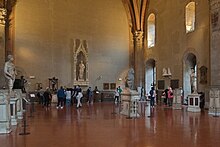
About the table
editThe table is designed to be sorted in the best logical way possible, so that it can be used productively for searches, statistics and analysis (with many compromises, see below. The sorting function will also be available in the app sometime). Technical terms, places, etc. are only linked once at first appearance.
Subject/Name
editFirst of all, it must be said that almost none of Donatello's works at the time had an individual name or title (just as only a few were signed; sometimes they have got inscriptions that were created later, as with the Campanile figures). In addition to the prophet Habakkuk, who was quickly nicknamed Zuccone because of his pumpkin-shaped head, the late Judith and the ancient Dovizia on the main market square (today's Piazza della Repubblica) in Florence, which was also unique at the time, to clearly identify a work, the addition of the place (or commissioner) and (if you knew it) the artist's name was needed. The figure of David was just as unusual and for both statues it was generally known that Donatello had made them, but for the second one, the bronze David for the Medici, which became known just as soon, you had to differentiate by adding the place where it was installed, the client or the material. Almost all of the other sculptures were figures of Christ, the Madonna and Saints, which were everywhere and made up the entire iconographical canon of what could be depicted up to that point.
Bronze David, Pazzi Madonna and Cavalcanti Annunciation are all so-called Notnamen, short names that have been created over time by art historians since the 19th century , which have become established (with variants) and, particularly in the case of popular works, have become established in general through art literature, cultural and travel guides. A very special case in this regard is the so-called Amor-Attis, Amor-At(t)ys and vice versa, or also Atys-Amorino, as Horst W. Janson described it in his monograph, which is still fundamental to this day, he remains a mystery with its ambiguous ancient attributes. Another persistent enigma is of course the bronze David.
Perhaps contrary to expectations, in the table these Notnamen under “Subject/Name” follow (in italics) after a general descriptive name of the object (e.g. “Lion..., (Marzocco)”), so that all prophet figures, for example, or the five John the Baptist can be brought together. Likewise, all Madonnas and Virgins with the Christ child are referred to as “Madonna and Child” so that they can be compared; the Pazzi Madonna, for example, can be found as “Madonna and Child, (Pazzi Madonna)”.
Donatello's documented collaborators and assistants are then named in small boldface, followed by uncertain attributions, dates or functions in small, bold and italic, which is a reference to missing documentation. Separating the largely undisputed works attributed to Donatello from those secured by documents or omitting them entirely would not allow an overall view of his oeuvre, to approximate the assumed simultaneous work on different genres and their chronological progression.
Form
editUnder “Form” the statues in particular can be separated from the relief works, although at the same time e.g. all niche figures can also come together.
Materials
editDonatello worked with a wide variety of materials, most often in innovative ways. In his time and also due to Donatello, in addition to marble, the complex and expensive bronze and cheap, easy-to-handle fired clay (terracotta) became the essential materials; almost exclusively white marble, especially for the early statues of the Florentine Cathedral, the stiacciato reliefs, the tombs and the two pulpits from the 1930s. Bronze, whose technique was almost lost and whose renaissance is associated above all with Lorenzo Ghiberti, his doors for the Baptistery of San Giovanni and the statues for Orsanmichele.[2], for which Donatello then made his first bronze figure, the Saint Louis of Toulouse (1418–1422).
The main material used for the main object of a work is always mentioned first, then its treatment and secondary materials (as in the “St. Louis of Toulouse with niche”, first “bronze, fire-gilt”, then silver, enamel and rock crystal for the decoration of the bishop's crosier, and finally the marble for the niche in which the figure originally stood, that was also created by Donatello).
Dimensions
editIn the 15th century, a locally applicable ell (or arm length) was applicable, which could range between around 50 and 75 cm. The size of a sculpture may have been specified as such in contracts or described in sources. In Donatello's case, the Florentine braccio (Italian "arm") of 58.3 cm was used for the most part.
If height × width × depth is not specified in the table as measurements (in centimeters), at least the height of a figure or the diameter (d) of a tondo, if that was the only way it could be found in the literature.
Dating
editWhen it comes to dating the work, a compromise had to be made in that the initial dates are decisive here. This means that for documented objects it is often the date of the (first) written commission or the decision to do so. However, as is often the case (at this time) and not only for Donatello, the completion of a work or even the beginning lay sometimes years in the future. The specified time period does not therefore mean the actual time that Donatello spent on a work. Especially since, even at the other end, that is, after Donatello had completed a sculpture, a considerable amount of time could pass before it was (as is often the case) primed and colored and also gilded by painters. The installation on site did not have to happen immediately, so such information in documents does not necessarily mean the time at which the sculpture was finished.
The priority of the starting date ignores the fact that during the period of often non-continuous work on a work, the understanding, the general knowledge of the classical model, with which Donatello continuously dealt, as well as the access to a specific task could change. This means that during the work process a stylistic change could take place that was not foreseeable at the beginning, or technical difficulties (or other circumstances) could arise that had to be solved and perhaps lead to a different result than it was originally planned.
Examples here include the early works, especially the marble David, whose speculative reworkings were the subject of much riddling.[3] Is the composition of the Louis of Toulouse in several parts, rather than cast in one piece, as Ghiberti had done, due to Donatello's deficits in the knowledge of bronze casting or was this based on a practical consideration regarding fire gilding or perhaps the complexity of the folds? The question of its open back (original or removed for Santa Croce?) will continue to concern art historians.
Locations
editThe locations always start with the city, then the building in or on which the work was or is located. Under original location there is also information that names the client or clients or allows conclusions to be drawn about them. An (early) relocation of a work is also noted (e.g. with both David figures). Today's location indicates in part the inventory number of the object (“Inv. xy”) if it is part of a museum collection, if possible with a link to the institution's online catalog where –as with the Berlin collection– good images can be found, a detailed description and documentation, as well as a bibliography.
About the second table
editImportant here are the controversial works, which have always been close to the discussion about Donatello's work, but which are refused to be included in the catalog of works that can be considered secure. Particularly worth mentioning here are the portrait bust of Niccolò Uzzano, the Saint Peter at Orsanmichele and the Hildburgh Madonna and its derivatives.
Furthermore, the nature of the second table means that it cannot be complete. As far as casts and variants of mostly smaller to minute works are concerned, there may be a huge number scattered throughout museums and private collections that have received undocumented attributions based solely on stylistic similarities. This also applies to works based on Donatello's designs since the supposed designs no longer exist. The heraldic shields in particular, often with Donatello's trademark, the spiritelli, are probably all workshop products at best. Due to the lack of sources, there is no section for original location here, but one for the attribution appears as second column.
All of the works listed here may be considered examples, with an obvious emphasis on works from the Berlin Sculpture Collection in the Bode Museum, which has historical and practical reasons. On the one hand, the early Italian Renaissance and Donatello in particular have been the focus of collecting activities and research since the end of the 19th century, especially of Wilhelm von Bode, which was then basically continued to this day. This is reflected in today's online catalogue, most of the works are excellently documented.[4] This is also a reason for selecting the pieces from other museums, the Victoria and Albert in London, which was similarly engaged as Berlin, the American collections of the National Gallery in Washington, the Detroit Institute of Arts and of course the museums in Florence itself, Donatello's birthplace and center of his professional life.[5]
Catalogue of works
edit| Image | Subject/Name | Form | Material | Dimensions (in cm) | Dating | Original location | Current location |
|---|---|---|---|---|---|---|---|
 |
Prophet | statue | marble | 128 | 1406 | Florence, Santa Maria del Fiore, Porta della Mandorla | Florence, Museo dell'Opera del Duomo |
 |
Christ as Man of Sorrows | relief | marble | 1407–1408 | Florence, Santa Maria del Fiore, Porta della Mandorla | Florence, Museo dell'Opera del Duomo. Copy on original site | |
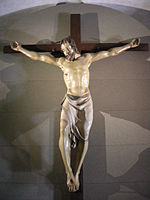 |
Crucifix | statue (demountable, with retractable arms) | wood, gesso primer, painted | 170 × 166 × 35 | 1407–1408 | Florence, Santa Croce, north transept | Florence, Santa Croce, Cappella Bardi di Vernio |
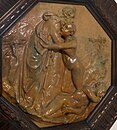 |
Creation of Eve, Damnation of Eve and Adam, Expulsion from Eden, The Labour of Adam and Eve – function, attribution and date arguable[6] |
reliefs (4), octagonal, probably for a hope chest (cassone) | terracotta, lead-glazed, partly gilded | 1408, ca. | unknown | London, Victoria and Albert Museum (formerly South Kensington Museum) (Inv. ? 3) and one in Florence, Museo dell’Opera del Duomo | |
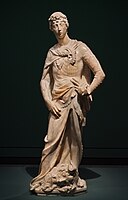 |
David (with the head of Goliath, marble David) | statue | marble, originally with cord of the sling | 191,5 × 78,5 × 42 | 1408–1409, 1416 | Florence, Santa Maria del Fiore, planned for north tribune; Palazzo della Signoria, Sala dei Gigli (1416) | Florence, Bargello (since 1781, Inv. Sc. 2) |
 |
John the Evangelist | statue in niche, sitting | marble | 210 | 1408–1415[7] | Florence, Santa Maria del Fiore, façade | Florence, Museo dell'Opera del Duomo |
| Prophet Joshua | statue | terracotta, stucco, white-washed | 550, circa | 1409–1412 | Florence, Santa Maria del Fiore, north tribune | deteriorated, not preserved | |
| Madonna and Child | statue | terracotta, gesso primer, painted | 1410–1412 | unknown | Empoli, Pontorme, San Martino | ||
  |
Saint Mark | statue in niche | marble | 236 × 74 (with base) | 1411–1413[8] | Florence, Orsanmichele, niche of the Arte dei Linaioli e Rigattieri (Guild of linen manufacturers and retail cloth dealers) | Florence, Orsanmichele, Museum. Copy at original site |
 |
Madonna and Child – attribution and date arguable |
statue, sitting | terracotta, originally primed and painted | 73 × 45,3 × 36,5 | 1414, ca. | unknown | London, Victoria and Albert Museum (Inv. 7573-1861) |
| Madonna and Child – attribution and date arguable |
statue, sitting | terracotta, gesso primer, painted | 68,6 × 37,8 × 38,1 38,1 kg |
1414, ca. | unknown | Detroit, Institute of Arts (Inv. 40.19) | |
 |
Madonna and Child (Huldschinsky Madonna) – attribution and date arguable |
statue, half figure | terracotta, originally primed and painted | 90 × 75 × 24 | 1415, ca. | unknown | Berlin, Bode Museum (formerly Kaiser Friedrich Museum), Sculpture Collection and Museum of Byzantine Art (since 1892, Inv. 1940) |
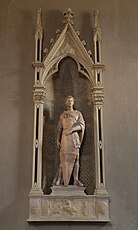 |
Saint George and
|
statue in niche with low reliefs | marble, probably at times with lance or sword and helmet (metal) | 204 × 78 × 34 base relief: 39 × 120 |
1415–1417, ca. | Florence, Orsanmichele, north side, niche of the Arte dei Corazzai e Spadai (Guild of the armourers and swordsmiths) | Florence, Bargello (in copied niche). Copy at original site |
 |
Madonna and Child and Two Angels | tabernacle, relief | terracotta, originally primed and painted | 96,5 × 67,5 × 13,5 | 1415–1420, ca. | unknown | Prato, Museo di Palazzo Pretorio (since 1871, Inv. 1876) |
  |
Prophets:
|
statues in niches (first two of six) | marble | 190 × 59 × 43, 193 × 64 × 44 (incl. plinth) |
1416–1418 and 1418–1420 | Florence, Santa Maria del Fiore, Campanile (all four on north side were moved to the east side in 1464)[9] | Florence, Museo dell'Opera del Duomo (copies on east site)[10] |
 |
Lion with coat of arms of Florence (Marzocco) | statue on column | sandstone (macigno), marble, rosso di Maremma | 135,5 × 38 × 60 | 1418–1420 | Florence, Santa Maria Novella, stairs to papal chambers | Florence, Bargello |
 |
Saint John the Baptist with Nanni di Bartolo, revised unfinished Joshua by Bernardo Ciuffagni[11] |
statue in niche (third of six) | marble | 207 × 65 × 44 | 1420–1421 | Florence, Santa Maria del Fiore, Campanile | Florence, Museo dell'Opera del Duomo (copy on original site)[12] |
 |
Saint Louis of Toulouse with niche maybe with Michelozzo di Bartolommeo |
statue and architecture of aedicula | bronze, fire-gilded (ormolu), silver, enamel, rock crystal and marble | 285 × 101 × 78 | 1418–1422, ca. | Florence, Orsanmichele, east side, niche of the Parte Guelfa, moved ca. 1440s–50s in niche above portal of Santa Croce; since 1483 Doubting Thomas by Verrocchio in original niche | Florence, Museo dell'Opera di Santa Croce |
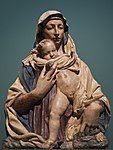 |
Madonna and Child (Madonna of the Cords) – attribution and date arguable |
relief | terracotta, gesso primer, painted | 89 × 64 × 28 | 1420–1423, ca. | unknown | Florence, Museo Civici Fiorentini - Museo Stefano Bardini (Inv. MCF-MB 1922-682) |
 |
Flagellation of Christ – function, attribution and date arguable |
relief, low | marble | 46,5 × 57,5 × 5 | 1420–1425, ca. | unknown | Moscow, Pushkin Museum, 1893–1945 in Berlin, Kaiser Friedrich Museum (henceforth solely as plaster cast) |
 |
Abraham and Isaac with Nanni di Bartolo |
statue in niche (fourth of six) | marble | 188 × 56 × 45 | 1421 | Florence, Santa Maria del Fiore, Campanile | Florence, Museo dell'Opera del Duomo (copy on east side of Campanile) |
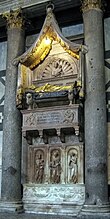 |
Tomb of Antipope John' XXIII: tomb effigy. base, statues of virtues, sarcophagus, lunette with Madonna and Child, baldachin with Michelozzo and Pagno di Lapo Portigiani |
gisant, architecture, relief | marble, partly painted and gilded, bronze, fire-gilded | 213 (length of gisant) | 1421–1427, ca. | Florence, Baptistery San Giovanni | Florence, Baptistery San Giovanni |
 |
Prophet and Sibyl[13] | relief, profile busts | marble | 64, each | 1422 | Florence, Santa Maria del Fiore, Porta della Mandorla | Florence, Santa Maria del Fiore, Porta della Mandorla |
 |
Madonna and Child (Pazzi Madonna) | relief, low | marble | 74,5 × 73 × 6,5 | 1422, ca. | unknown, thought to be owned by the Pazzi family | Berlin, Bode Museum (since 1886, Inv. 51) |
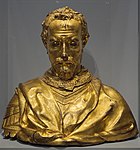 |
Reliquary Bust of Saint Rossore (= Saint Luxorius)[14]</ref>[15] | bust, reliquary with lit and halo (lost) | bronze, fire-gilded | 55 × 58 × 42 | 1422–1425, ca. | Florence, Ognissanti, since 1591 in Pisa, Santo Stefano dei Cavalieri[16] | Pisa, Museo nazionale di San Matteo (since 1977) |
 |
Prophet Jeremiah | statue in niche (fifth of six) | marble | 191 × 45 × 45 | 1423, ca. | Florence, Santa Maria del Fiore, west side of Campanile | Florence, Museo dell'Opera del Duomo (copy on original site) |
 |
Saint John the Baptist[17] | statue | bronze, patinated | 90,5 × 36,5 × 30 | 1423–24 | Orvieto, Cattedrale di Santa Maria Assunta, baptistery font – uncertain |
Moscow, Pushkin Museum, 1878 from Palazzo Strozzi until 1945 in Berlin, Kaiser Friedrich Museum (henceforth solely as plaster cast) |
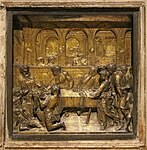 |
Feast of Herod | relief (one on the hexagonal parapet) | bronze, fire-gilded | 60 × 61 | 1423–1427 | Siena, Baptistery of San Giovanni, baptistery font | Siena, Baptistery |
 |
Madonna and Child and Four Angels (Madonna of the Clouds) | relief | marble | 34 × 32,1 × 2,8 | 1425–1430, ca. | Florence, Palazzo vecchio di Medici, guardaroba of Cosimo († 1464), afterwards in posession of Piero del Pugliese | Boston, Museum of Fine Arts (Inv. 17.1470) |
 |
Prophet Habakuk (Zuccone) | statue in niche (last of six) | marble | 195 × 54 × 38 | 1426–ca. 1427 and 1435–1436 | Florence, Santa Maria del Fiore, Campanile | Florence, Museo dell'Opera del Duomo (copy on west side of the Campanile) |
  |
Tomb of Cardinal Rainaldo Brancacci: Annunciation relief all other design and execution by Michelozzo (and workshop) |
relief, low; tomb monument with statues and reliefs, partly painted and gilded | marble | 74 × 78 (relief) | 1426–1428 | Neapel, Sant’Angelo a Nilo | Neapel, Sant'Angelo a Nilo |
  |
Faith and Hope | statuettes, two (of six) corner figures | bronze, fire-gilded | 52, each | 1427–1429 | Siena, Baptistery San Giovanni, baptistery font | Siena, Baptistery |
 |
Ascension with Christ Giving the Keys to Saint Peter | relief, low | marble | 41 × 115 | 1428–1430 | Florence, 1492 owned by Lorenzo de' Medicis, then by the Salviati until after 1677[18] | London, Victoria and Albert Museum (Inv. 7629-1861) |
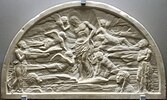 |
Christ's Blood | relief | marble | 39,8 × 67 | 1429–1430 | Siena (province), Torrita di Siena, Oratorio della Madonna delle Nevi | Siena (province), Torrita di Siena, Chiesa delle Sante Flora e Lucilla |
  |
Spiritelli, making music with trumpet resp. tambourine | statuettes | bronze, fire-gilded | 40 × 20 × 15,8 36,2 × 14,7 × 16,2 |
1429 | Siena, Baptistery San Giovanni, baptistery font | Siena, Baptistery San Giovanni, baptistery font (w/ trumpet), Berlin, Bode Museum (Inv. 2653), a third maybe in Florence, Bargello (Inv. ) |
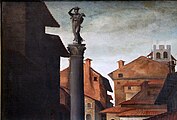 [19] [19] |
Dovizia (on the Colonna dell'Abbondanza) | statue on column | sandstone (macigno) | 1431 | Florence, Mercato (vecchio), now Piazza della Repubblica | deteriorated and destroyed in a fall in 1721 (replaced with a version by Giovanni Battista Foggini, also replaced by a copy) | |
 |
Tomb slab for the papal secretary Giovanni Crivelli | relief, low | marble | 235 × 88 | 1432 | Rome, Santa Maria in Ara Coeli | Rome, Santa Maria in Ara Coeli |
 |
Tabernacle (for the Eucharist) | relief | marble | 225 × 120 | 1432 | Rome, Apostolic Palace, Capella Parva | Rome (Vatican), St. Peter's Basilica |
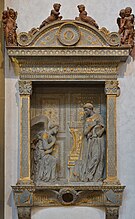 |
Altar piece (Cavalcanti Annunciation) | relief in tabernacle, group of six statuettes | sandstone (macigno), painted white/gray with gilding terracotta (spiritelli) |
419 | 1433–35, ca. | Florence, Santa Croce, for the Cavalcanti family chapel | Florence, Santa Croce |
 |
Pulpit for organ or singers, Cantoria | reliefs of triforium on corbels and columns | marble, mosaic, bronze | 348 × 570 | 1433–1439 | Florence, Santa Maria del Fiore | Florence, Museo dell'Opera del Duomo |
 |
Coronation of the Virgin (design)[20] | leadlight, oculus | cartoon | 380, ca. | 1434–1437 | Florence, Santa Maria del Fiore, eastern arch of the crossing (above the choir) | Florence, Santa Maria del Fiore |
   |
Pulpit of the Holy Girdle
in part by workshop by Michelozzo[21]
planned with Michelozzo, executed by workshop (Pagno di Lapo Portigiani) and specialists on the spot |
reliefs (seven) | marble, mosaic (glass casting, glazed ceramic, formerly gilded tesserae) for parapet bronze, fire-gilded (capital) |
77 × 86 × 12 (each relief) 94,5 × 143,5 × 50 (capital) |
1434–1438 (parapet, after new contract) commission of 1428, cast of capital at the end of 1433 |
Prato, Cathedral (then Pieve di Santo Stefano), southwest corner of façade | Prato, Cathedral and Cathedral Museum (1976, Inv. AGJ2748, [...] and AGJ1829); copies on original site |
 |
Old Sacristy[22]
architecture designed by Filippo Brunelleschi |
reliefs, architectural frames | bronze (doors), painted stucco (tondi and lunettes), sandstone (macigno) | 215 d, ca. (tondi w/o molding) ca. 215 × 180 (lunettes w/o frame) 235 × 109 (each door with ten reliefs of 36,5 × 33,5 l, 34,5 r, both at bottom 35) |
1434–1443 | Florence, San Lorenzo | Florence, San Lorenzo |
 |
Feast of Herod | relief, low | marble | 50 × 71,3 × 5 | 1435, ca. | unknown | Lille, Palais des Beaux-Arts (Inv. Pl 1912) |
| Madonna and Child (Goretti Miniati Madonna) | relief | marble | 62,6 × 43,5; 5 (relief) | 1435, ca. | unknown | Florence, Bargello (Inv. Sc 470) | |
 |
Dead Christ Tended by Angels (Imago Pietatis) – function, attribution and date arguable |
relief, low | marble | 80,5 × 114,3 × 6 | 1435, ca. | unknown | London, Victoria and Albert Museum (Inv. 7577-1861) |
 |
David with Sword and Severed Head of Goliath (bronze David) | statue on column (lost or as remains, original height over 2 m) | bronze, partly fire-gilded marble (attributed column remains) |
159 | 1435–1440 | Florence, Casa Vecchia de’ Medici, maybe at first in the old Medici palace, after 1457 in the court of Palazzo Medici, 1495 in the court of Palazzo della Signoria | Florence, Bargello |
 |
Spiritello (Amor-Attis) | statue | bronze, partly fire-gilded | 103 × 55 × 45 | 1435–1440, ca. | Florence | Florence, Bargello (since 1778, Inv. Br. 448) |
  |
Spiritelli Candle-Holders (two) | statuettes, candelabra | bronze, gilding | 58,5 × 42 × 28 65 × 32,5 × 22 |
1436–1438, ca. | Florence, Santa Maria del Fiore, for organ pulpit by Luca della Robbia | Paris, Institut de France, Musée Jacquemart-André (Inv. MJAP-S 1773-1 and 2) |
 |
Saint John the Baptist | statue | wood, gesso primer/stucco, painted and gilded | 1438 | Venedig, Santa Maria Gloriosa dei Frari | Venedig, Santa Maria Gloriosa dei Frari | |
| Saint Lawrence – attribution and date arguable |
half figure | terracotta, formerly painted | 74,5 × 62 | 1440, ca. | private ownership | ||
 |
Madonna and Child (Dudley Madonna) | relief, low | marble | 27,2 × 16,5 × 2 | 1440, ca. | unknown | London, Victoria and Albert Museum (Inv. A.84-1927) |
 |
Madonna and Child (Piot Madonna) | relief | terracotta, wax, glass, formerly gilded | 74 × 75 × 7 | 1440, ca. | unknown | Paris, Louvre (since 1890, Inv. RF 3967) |
 |
Madonna and Child (Madonna of the Cherubs) | relief with intarsia | terracotta, gesso primer/stucco, painted and gilded | 99,6 × 69,5 20 | 1440–1445, ca. | unknown | Berlin, Bode Museum (since 1888, Inv. 54) |
 |
Madonna and Child (Madonna dell'Umiltà Crowned by Two Angels) | relief tondo, gilded (in tabernacle by Desiderio da Settignano or Andrea Verrocchio) | bronze, fire-gilded | 27 d (87 × 51 × 12) |
1440–1445, ca. (tabernacle shortly after) |
unknown | Wien, Kunsthistorisches Museum, Kunstkammer (Inv. KK 7462) |
 |
Mary Magdalene (Penitent Magdalene) | statue | wood, gesso primer/stucco, painted and gilded | 188 | 1440–1442 | Florence, Baptistery San Giovanni | Florence, Museo dell'Opera del Duomo |
 |
Crucifix | statue on cross | wood, gesso primer/stucco, painted | 192 × 185 | 1440–1445 | Padua, Santa Maria dei Servi | Padua, Santa Maria dei Servi |
 |
Saint John the Baptist (San Giovannino Martelli) – function, attribution and date arguable |
statue, in the round, with halo and rod with cross | marble, gilded bronze | 159,5 (165) × 46,5 × 36 | 1442, ca. | Florence, Casa Martelli | Florence, Bargello (1913 from the Martelli family, Inv. Sc. 435) |
 |
Crucifix | statue on cross | bronze | 176 × 170 × 41 | 1443/44–1448/49 | Padua, Basilica di Sant'Antonio, rood screen | Padua, Museo Antoniano |
| Madonna and Child | relief, low | terracotta, gesso primer/stucco, painted | 102 × 74 × 12, 112 kg | 1445–1455, ca. | Val d'Elsa, Vigliano, San Lorenzo chapel | Paris, Louvre (1881, Inv. RF 353) | |
 |
High altar
|
statues (7) and 22 reliefs | bronze, patinated, partly fire-gilded (statues and reliefs) limestone (Entombment), white and coloured marble (altar) |
123–164 (statues) 57 × 123 or 57, ca (each relief) |
1446–1449 | Padua, Basilica of Saint Anthony | Padua, Basilica of Saint Anthony (19th ct. reconstruction)[23] |
 |
Gattamelata Monument (Condottiere Erasmo da Narni) | Equestrian statue on pedestal with two reliefs and inscription | bronze, patinated marble (reliefs and plinth) sandstone (pedestal) |
1446–1453, ca. | Padua, Piazza Sant'Antonio | Padua, Piazza Sant'Antonio | |
 |
Tomb slap of Giovanni Pecci (Bishop of Grosseto, † 1427) | relief, low | bronze, enamel inlays with glass, mostly lost | 249,5 × 106,8 × 3 | 1448–1450 | Siena, Cathedral, crossing, moved to St. Ansanus chapel (under Pecci patronage) in the 16th ct. | Siena, Cathedral, St. Ansanus chapel |
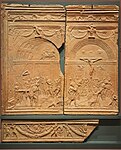 |
Flagellation of Christ and Crucifixion, predella frieze with spiritelli (Forzori Altar) bozzetto |
relief, low, damaged | terracotta | 53,5 × 27,1 × 4,5 (Flagellation) 54,7 × 30,5 × 5 (Crucifixion) 11,2 × 48,5 × 2,3 (Predella) |
1450, ca. | Florence, owned by Forzori family | London, Victoria and Albert Museum (Inv. 7619 1-3-1861) |
 |
Madonna and Child | relief, low | terracotta, gesso, painted | 70 × 55 × 2 | 1450, ca. | unknown | Paris, Louvre (1986, Inv. RF 744) |
 |
Calvary (Camondo Calvary) – function, attribution and date arguable |
relief, low | bronze, formerly partly gilded | 42,8 × 28,7 × 4,5 | 1450–1452 | unknown (private commission) | Paris, Louvre (1897, Inv. OA 6477) |
 |
Madonna and Child and Four Angels (Chellini Madonna) | relief tondo, low, flipside shows negative of relief usable to cast copies | bronze, gilded | 28,5 d, 2,7, 4.2 kg | 1450–1455 | Florence, gift of Donatello to his doctor Giovanni Chellini | London, Victoria and Albert Museum (Inv. A.I-1976) |
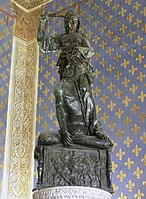 |
Judith and Holofernes | sculptural group on triangular pedestal with three reliefs | bronze | 236 | 1453–1457 | Florence, Palazzo Medici, garden, after 1494 in the Loggia dei Lanzi on the Piazza della Signoria | Florence, Palazzo Vecchio |
 |
Saint John the Baptist | statue | bronze | 185 | 1455, ca. | Siena, Cathedral | Siena, Cathedral |
 |
Bearded Head (Prophet?) – function, attribution and date arguable |
bust | bronze | 37 × 23 × 27 | 1455, ca. | Florence | Florence, Bargello (Inv. Br. 101) |
| Madonna and Child (Seggiolino Madonna) | relief | terracotta, gilded | 74,3 × 55,9 | 1455, ca. | London, Victoria and Albert Museum (Inv. 57:1&2-1867) | ||
 |
Calvary | relief, low | bronze, partly gilded, silver, gilded copper | 93 × 70 × 3,5 | 1455–1465 | Florence, private commission, since 16th ct. owned by the Medici | Florence, Bargello (Inv. Br. 443) |
 |
Horse's Head (Protome Carafa) – function, attribution and date arguable |
protome, propably part of an equestrian statue not executed | bronze | 187 × 185 × 80 | 1456 | Naples, Castel Nuovo, triumphal arch (planned, commission by Alfonso of Aragon, † 1558) | Naples, Museo Archeologico Nazionale (Inv. 4887), from the Palazzo Carafa |
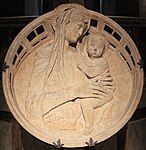 |
Madonna and Child (Madonna del Perdono) | relief | marble, white and coloured | 91 × 88,2 | 1458, ca. | Siena, Cathedral, Vergine delle Grazie chapel | Siena, Museo dell'Opera del'Duomo |
| Lamentation of Christ probably a bozzetto |
relief, chasing | bronze | 32,1 × 41,7 × 6,3 | 1458–1460 | Siena, propably planned for the bronze doors of the Cathedral | London, Victoria and Albert Museum (Inv. 8552-1863) | |
 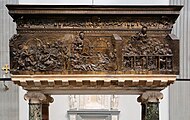 |
Passion of Christ and Resurrection scenes completion by Bartolomeo Bellano, Bertoldo di Giovanni and others – original function unclear |
reliefs (), mounted into a free standing chancel in the 16th ct. | bronze | 123 × 292 | 1461–1466 | Florence, San Lorenzo | Florence, San Lorenzo |
Arguable attributions, casts, variants and works after models by Donatello
edit| Image | Attribution | Subject/Name | Form | Material | Dimensions (in cm) | Year | Location |
|---|---|---|---|---|---|---|---|
 |
Donatello attributed[24] | Madonna and Child | relief | terracotta, gesso primer/stucco, painted, wooden back | 102,5 × 62,2 × 28,3 | 1410–15, ca. | Washington, National Gallery of Art, Samuel L. Kress Collection (Inv. 1943.4.93) |
| Nanni di Bartolo | Madonna and Child | statue | terracotta, painted | 47 × 35 × 10,5 | 1420, ca. | Berlin, Bode Museum (since 1913, Inv. M 7174) | |
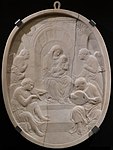 |
Donatello workshop | Madonna and Child and Four Angels (Hildburgh Madonna) – function, attribution and date arguable |
relief, low | marble | 41,5 × 32,5 × 3,4 | 1420–1430, ca. | London, Victoria and Albert Museum (Inv. A.98-1956) |
 |
after Hildburgh Madonna attributed to Donatello | Madonna and Child, Two Angels, Saint Bartholomew ana a Crowned Saint | tabernacle, relief | stucco, gilded and painted | 40,6 × 30,5 (relief) 76,2 × 38,1 × 7,5 |
1420–30, ca. | London, Victoria and Albert Museum (Inv. 93-1882) |
 |
Donatello attributed | Christi Geburt (Ford Nativity) |
relief | terracotta, formerly painted and gilded | 47 × 35.6 × 8.3 (incl. frame: 82.6 × 48.3 × 8.3) |
1420–1430, ca. | Detroit, Institute of Arts (Inv. F76.92) |
 |
Donatello attributed | Madonna and Child (Mellon-Madonna) |
statue | terracotta, painted and gilded | 120,8 × 47,2 × 33,5 | 1422, ca. | Washington, National Gallery of Art, A. Mellon Collection (Inv. 1937.I.112) |
 |
after Donatello | Madonna and Child in einer niche | relief, low | bronze, gilded | 20,5 × 15,5 × 1 | 1426–30, ca. (Prototyp) | Berlin, Bode Museum (Inv. 3044)[25] |
| after Donatello | Madonna and Child in a niche | relief, low | bronze, gilded | 20,4 × 15,3 × 8 | 1426–30, ca. (prototype) | Washington, National Gallery of Art, Samuel L. Kress Collection (Inv. 1957.14.131) | |
 |
after Donatello | Madonna and Child (Maria lactans) | relief, low | Blei | 11,3 × 9,3 | 1430, ca. | Berlin, Bode Museum (Inv. 1028)[26] |
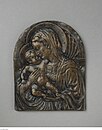 |
unknown, maybe Michelozzo di Bartolomeo | Madonna and Child vor einer niche | relief, low, plaquette | Kupferlegierung | 9,8 × 7,8 | 1430, ca. | London, Wallace Collection (Inv. S299)[27] |
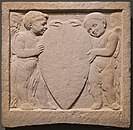 |
maybe workshop of Donatello and Michelozzo | Spiritelli with Escutcheon | relief, low | sandstone (pietra serena?), probably originally painted | 59,5 × 61 × 5 | 1432, ca. | Berlin, Bode Museum (since 1916, Inv. 7210) |
 |
Paolo Schiavo, painted and framed relief after model by Donatello | Madonna and Child Between Angels , Godfather, Eve and a crowned Prophet | tabernacle, relief | stucco (relief) in wooden framing, painted and gilded | 12,1 × 9,5 (relief) 36,5 × 20,2 × 5,2 |
1435, ca. | London, Victoria and Albert Museum (Inv. A.45-1926) |
 |
maybe Donatello workshop | Spiritello with Fish | statuette, propably from a font at a wall | bronze | 40,5 × 40,4 × 11, 7 kg | 1435–1440 | London, Victoria and Albert Museum (Inv. 475-1864) |
 |
after Donatello | Madonna and Child (Pugliese Dudley Madonna) |
relief, low | stucco, painted | 31,5 × 21 | 1440, ca. (Prototyp) | Berlin, Bode Museum (Inv. 2627) |
 |
Desiderio da Settignano, alt. Donatello attributed | Bust of Niccolò da Uzzano | portrait bust | terracotta, painted | 46 h | 1440–1455 | Florence, Bargello |
 |
maybe Donatello workshop | Madonna and Child (Madonna dei Cordai) |
relief | stucco, leather, glass and wax on wood, painted, gilded and silvered | 93 × 78 | 1440–1460 | Florence, Museo Bardini |
 |
after Donatello | Madonna and Child | relief, low | stucco, painted | 99 × 66,6 × 11,5 | 1450, ca. (prototype) | Berlin, Bode Museum (Inv. 2634) |
 |
Donatello workshop | Madonna and Child (copy of Pazzi Madonna) | relief in tabernacle | terracotta, painted and gilded | 70 × 55 × 2 (relief only) | 1450, ca. | Paris, Louvre (Inv. RF 744) |
 |
Donatello attributed | Playing Cherubs (Spiritelli) |
relief | bronze | 4.8 × 8.4 × 0.5 | 1450er, (mid 15th ct.) | Detroit, Institute of Arts (Inv. F70.32) |
 |
Donatello attributed | Coat of Arms of the Martelli Family | relief | sandstone (macigno), primer, painted | 109,2 | 1450er, (mid 15th ct.) | Detroit Institute of Arts (1925, Inv. 25.156) |
 |
Donatello attributed or the model executed under his direction by the workshop of Desiderio and Geri da Settignano[28] | Coat of Arms of the Martelli family | relief | sandstone (pietra serena), partly painted and gilded | 1455, ca. | Florence, Bargello (Inv. 532 S) | |
| after Donatello | Crucifixion | relief, low | stucco on poplar with remnants of gilding | 36,5 × 26,5 × 7,5 | 1455–1470 | Berlin, Bode Museum (Inv. 53) | |
 |
Desiderio da Settignano[29] | Coat of Arms of Boni family | relief | sandstone (pietra serena) | 215,9 × 74,3 | 1456-1458, ca. | Detroit, Institute of Arts (Gift of Mr. and Mrs. Edsel B. Ford, Inv. 41.124) |
 |
Cast after a lost model attributed to Donatello | David with the Severed Head of Goliath probably a bozzetto |
statuette | bronze (after a wax model) | 36,8 × 10,3 × 10 | 1460–1465 | Berlin, Bode Museum (Inv. 2262) |
 |
Donatello attributed | Madonna and Child and Five Angels probably a bozzetto |
relief | terracotta, originally painted | 21,5 × 15,5 × 4,2 | 1465, ca. | Berlin, Bode Museum (Inv. M 88) |
References
edit- ^ See References. The traveling exhibition was the rare and so far last major monographic exhibition project on Donatello's work.
- ^ The first bronze portal for the Baptistery was created by Andrea Pisano between 1330–1336 based on the model of the bronze doors by Bonanno Pisano from around 1180 at Pisa Cathedral, of which only the Porta San Ranieri survived. For its implementation, bronze casters had to be appointed from Venice, one of the last places where the late Antique-Byzantine tradition dominated and the associated knowledge was still cultivated. In addition, Florence was in good economic shape at the beginning of the 14th century, but this was no longer the case for the next few decades due to plagues and wars. Antonio Paolucci (1997). Die Bronzetüren des Baptisteriums in Florenz. Munich: Hirmer. pp. 8ff. ISBN 3-7774-7370 -7.
Ghiberti's doors were created between 1403–1424 and 1425–1452. The Baptist John from 1412–1416 for the Arte di Calimala (wool merchants) was the first bronze statue of this size since antiquity. This was followed by the St. Matthew (1419–1423) and St. Stephen (1425–1428) for the equally (influential) guilds of money changers (Cambio) and linen weavers (Lana). Richard Krautheimer, Trude Krautheimer-Hess (1958). "VI-VIII". Lorenzo Ghiberti. Princeton Monographs in Art and Archeology. Vol. 31 (1st Pb . In 1982 the 2nd ed.). Princeton: Princeton University Press. pp. 71ff. - ^ Janson, pp. 3–7. Pope-Hennessy (1993) changed his mind when he thought he could identify the 1408 statue with another in the cathedral museum. Pope-Hennessy 1996, p. 348.
- ^ Online-catalogue of the Staatliche Museen zu Berlin (SMB). They are part of the Prussian Cultural Heritage Foundation.
- ^ Their online presentation, for example the Uffizi, initially admired, is unfortunately no longer exemplary.
- ^ See Caglioti 2022, p. 118–119 with photographs of both objects.
- ^ Commission from December 19, 1408 for three evangelist figures to Niccolò Lamberti, Nanni di Banco and Donatello (plus one awarded to one of the three, then Bernardo Ciuffagni in 1410), on July 17, 1410 the chapels in the cathedral, which serve as workshops, locked, for which Donatello was paid a key in 1415. He received three payments for the statue until a reminder on April 16, 1415 to complete the figure by the end of May. Two more payments were made on May 10th and June 3rd. The installed statue was approved on October 8, 1415 and valued at 160 florins, of which 60 florins were still outstanding. Janson, p. 12f.
- ^ The commission by the Arte to Donatello dates from April 3, 1411. The statue, including gilding and other jewelry, should be finished and installed on November 1 of the following year. On April 24th, two stonemasons were commissioned to work on the niche. On April 29, 1413, the sculpture was approved. Janson, p. 17.
- ^ Caglioti 2022, p. 42.
- ^ On the east side of the Campanile stand today copies (from left to right) the Beardless Prophet, the so-called Pathetic Prophet by Giuliano da Poggibonsi, Abraham and Isaac, and the Profeta pensieroso.
- ^ According to Caglioti Donatello reworked the head, youthful and with thick hair, Nanni did the rest already outlined by Ciuffagni. Afterwards the figure was never called Joshua again. The Baptist holds a scroll in his hands, but doesn't wear his signature pelt. Caglioti, p. 41.
- ^ On the west side of the Campanile today are standing copies of the following statues, from left to right: This Saint John, the Zuccone, the Jeremiah and the Obadia by Nanni di Bartolo.
- ^ Payment for both busts on 13. May 1422, Janson, S. 43.
- ^ In his catasto of 1427, Donatello lists 15 florins that he owes to Giovanni di Jacopo degli Strozza for the "repeated bronze casting of the figure of St. Rossore and other things". The bust is not mentioned in Michelozzo's contemporaneous 'tax return', which excludes his involvement, Janson 1957, p. 56f. Also Anita Moskowitz, Donatello's Reliquary Bust of Saint Rossore. In: The Art Bulletin, Vol. 63, No. 1 (March 1981), pp. 41–48. Online as pdf on JSTOR
- ^ Anita Moskowitz, Donatello's Reliquary Bust of Saint Rossore. In: The Art Bulletin, Vol. 63, No. 1 (March 1981), p. 41–48. Online als pdf on JSTOR.
- ^ The head of St. Rossore was discovered as a relic in 1422 and brought by the Umiliati from Pisa to Florence. They gave Donatello the commission for the bust. Already in the middle of the 16th century they had to give Ognissanti away to the Franciscans, and moved to Santa Caterina degli Abbandonati. In 1570 the order was banned and their property was confiscated and sold. Janson 1957, p. 56.
- ^ On 10 February, 1423, the Soprastanti alla Fabbrica of the cathedral in Orvieto awarded a commission for a figure of the Baptist in gilded copper to Donatello, who received the wax for it on 29 April. No further documents. In 1461 a stucco figure was installed on the baptismal font, which, according to Janson, rules out that Donatello had supplied the figure (he was either too busy and gave up the job or the casting went wrong and was not tried again). Janson, p. 246f. A document from 1487 discovered in the mid-1980s in the Martelli's Palazzo, which the Strozzi later acquired, mentions a bronze figure of the Baptist by Donatello. At a 2015 exhibition in the Pushkin Museum, an analysis during the previous restoration revealed a "very high" copper content, a "peculiar" casting technique and tenoning (possibly similar to that of Louis of Toulouse). Caglioti identifies him with the Baptist for Orvieto, which later came into the possession of the Martelli. The attribution to Donatello is “absolutely undeniable.” V. Rastorguev in Rowley 2022, cat. 51, p. 234. Caglioti 2022, p. 43. Documents quoted from Lightbown 1980, p. 322.
- ^ Pope-Hennessy 1996, p. 350.
- ^ Filippo Napoletano (attr.), Piazza del Mercato Vecchio in Florence, ca. 1600–30, still with the Dovizia by Donatello.
- ^ executed by Domenico di Pietro da Pisa and Angelo di Lippo di Paolo, Caglioti 2022, p. 58 (Ill. 31, p. 55).
- ^ Only the Spiritello at the top looking down may be supposedly by Donatello. Rowley in Caglioti 2022, p. 214; furthermore his text on the pulpit, p. 210–13.
- ^ The old sacristy was built according to plans by Brunelleschi from 1422 (as was later the entire church of San Lorenzo). Donatello's share of the decorative equipment is huge and represents Donatello's largest coherent work. Even the sarcophagus decoration of the central tomb for Giovanni di Bicci de' Medici and his wife Piccarda Bueri, as part of the overall concept, clearly by Brunelleschi and others, executed by Brunelleschi's adoptive son Buggiano (actually Andrea de Lazzaro Cavalcanti), bears Donatello's signature and was at least also worked on by sculptors of his workshop. The decoration of the sacristy was worked from top to bottom, first the twisted fabric wound with a gold ribbon that decorates the supports of both domes, then the large tondi with the four evangelists and the four scenes from the Life of John the Evangelist, and the frieze of the architrave with spiritelli in small tondi (in alternating red and grey). Later came the lunette reliefs with Saints Stephen and Lorenzo, as well as Cosmas and Damian above the antique door gables and finally the bronze doors with their reliefs (although they could have been worked on before). According to Brunelleschi's biographer Antonio Manetti, the friends broke up over the door frames, which were not discussed with Brunelleschi. Donatello also begun the work on a washbasin (lavabo) for the left back room completed by Verrocchio. Caglioti 2022, p. 68–72, 232–239.
- ^ List of missing details and history of the various reconstruction designs with illustrations, see Janson 1957 II, p. 162ff and I, plates 257–318.
- ^ In the online catalogue of the National Gallery this sculpture is consciously described as "Florentine, 15th Century". In the catalogue of the 2022/23 touring exhibition Aldo Galli identifies it as by Donatello and the earliest example of this sculptural type of Madonna and Child, which subsequently replaced corresponding panel paintings. In Caglioti, p. 120.
- ^ The Wallace Collection in London has a version of the exact same size with an alloy of bronze, copper and lead (Inv. S297).
- ^ probably the earliest copy after a plaquette by Donatello, of which several were obtained by Wilhelm Bode for the Berlin collections, a. o. a larger version in terracotta (Inv. 56). Further copies can be found in other museums like the Musée Jacquemart-André in Paris Inv. MJAP-OA 2085 aus getriebenen and vergoldetem Kupfer. Discussion and bibliography on this model see entry in the Berlin online catalogue.
- ^ Eintrag im Online-Katalog der Wallace Collection. Die Sammlung enthält ein weiteres, sehr ähnliches Stück, allerdings ohne die Konche (Inv. S300); außerdem noch eine kleinere Plakette (Inv. S301), deren Herkunft man in Padua vermutet and um 1450 datiert.
- ^ Donatello and Desiderio had occasionally worked together, especially for the Martelli. This escutcheon was propably commissioned by Roberto Martelli for their new palazzo. Beatrice Paolozzi Strozzi, in Desiderio 2007, p. 69
- ^ Maybe as pupil of Donatello, or "Desiderio and Geri da Settignano after a model by Donatello?" according to Giancarlo Gentilini, in Desiderio 2007, p. 29.
Bibliography
edit- Horst W. Janson (1957). The Sculpture of Donatello (2 Vol.). Princeton: Princeton University Press.. Archive-URL of the 1963 edition in one volume with less images.
- John Pope-Hennessy (1996) [1958]. An Introduction to Italian Sculpture, Vol. 2: Italian Renaissance Sculpture (4., revised ed.). London: Phaidon.
- Francesco Caglioti with Laura Cavazzini, Aldo Galli and Neville Rowley (2022). Donatello. The Renaissance. Venice: Marsilio Arte. ISBN 979-12-5463-006-8.
- Neville Rowley with Francesco Caglioti, Laura Cavazzini and Aldo Galli (2022). Donatello. Erfinder der Renaissance. Leipzig: E.A. Seemann. ISBN 978-3-86502-482-4.
Further reading
edit- Avery, Charles, Donatello. Catalogo completo delle opere, Firenze 1991.
- Wilson, Carolyn C., Renaissance Small bronze Sculpture and Associated Decorative Arts, 1983, National Gallery of Art (Washington), ISBN 0894680676
External links
edit- The Chellini Madonna Sculpture. Victoria and Albert Museum
Category:Italian Renaissance sculptors Category:1380s births Category:1466 deaths Category:Sculptors from Florence Category:Italian male sculptors Category:15th-century people of the Republic of Florence Category:Burials at San Lorenzo, Florence Category:Italian Roman Catholics Category:Renaissance sculptors Category:15th-century Italian sculptors Category:Catholic sculptors
————————————————————————————————————————————————————————————————————————————————————————————————————————————————————————————
Frisell
edit| Artists | Title | Year | Label |
|---|---|---|---|
| Michel Herr, Bill Frisell, Vinton Johnson, Kermit Driscoll | Good Buddies | 1978 | EMI Belgium |
| Eberhard Weber | Fluid Rustle | 1979 | ECM |
| Emil Viklický, Bill Frisell, Kermit Driscoll, Vinton Johnson | Okno | 1981 | Supraphon |
| Arild Andersen | A Molde Concert | 1982 | ECM |
| Jan Garbarek | Paths, Prints | 1982 | ECM |
Hubbard
editAs sideman
edit| Main artist | Title | Label | Year |
|---|---|---|---|
| Manny Albam | The Soul of the City | Solid State | 1966 |
| Roberto Ávila & Sarava | Come to Brazil | Sonet | 1989 |
| George Benson | The Other Side of Abbey Road | A&M/CTI | 1969 |
| Walter Benton | Out of this World | Jazzland | 1960 |
| Art Blakey | Mosaic | Blue Note | 1961 |
| Art Blakey | Buhaina's Delight | Blue Note | 1961 |
Laurie Anderson
editOriginal audio work
editPeak positions of national charts are mentioned in the "Notes"
| Date | Artist | Album title | Label | Notes |
|---|---|---|---|---|
| 1977 | Various Artists | Airwaves | One Ten | "Two Record Anthology of Artists' Aural Work & Music", four tracks by L.A.: "Ethics Is the Esthetics of the Few-ture (Lenin)" and "Song for Juanita" for tape bow violin, "Is Anybody Home", "It's Not the Bullett, That Kills You, It's the Hole" with Scott Johnson, Peter Gordon a.o. |
| 1977 | Various Artists | New Music for Electronic and Recorded Media | 1750 Arch | Women only audio art compilation with two (of 8) tracks by L.A. with Scott Johnson: "New York Social Life", "Time to Go (For Diego)" |
| 1981 | Laurie Anderson, William S. Burroughs and John Giorno | You're the Guy I Want to Share My Money With | Giorno Poetry Systems | Compilation, first eight (of 18) tracks by L.A. with Perry Hoberman (1) and Wharton Tiers (3) |
| Date | Album title | Label | Notes |
|---|---|---|---|
| 1982 | Big Science | Warner | Debut album; US #124, NZ #8, UK #29[1] |
| 1984 | Mister Heartbreak | Warner | US #60, CH #19, NL #23, NZ #12, SE #46, UK #93[1] |
| 1984 | United States Live | Warner | Live performance, 5 LP (4 CD) boxed set; US #192 |
| 1986 | Home of the Brave | Warner | Soundtrack; US #145, NZ #14, SE #34 |
| 1989 | Strange Angels | Warner | US #171 |
| 1994 | Bright Red | Warner | US #195 |
| 1995 | The Ugly One with the Jewels | Warner | Spoken-word album |
| 2000 | Talk Normal: The Laurie Anderson Anthology | Warner | Compilation with remastered LP versions |
| 2001 | Life on a String | Nonesuch/Elektra Records | DE #84 |
| 2002 | Live at Town Hall New York City September 19-20, 2001 | Nonesuch | Live performance |
| 2010 | Homeland | Nonesuch | DE #62 [2], GR #41[3] |
| 2015 | Heart of a Dog | Nonesuch | Spoken-word, soundtrack |
Singles
edit- "O Superman" (1981) No. 2 UK;[1] BE (Vl) No. 19; IRL No. 11; NL No. 10; NZ No. 21
- "Big Science" (1981)
- "Sharkey's Day" (1984)
- "Language Is a Virus" (1986)
- "Strange Angels" (1989)
- "Babydoll" (1989) No. 7 US Modern Rock
- "Beautiful Red Dress" (1990)
- "In Our Sleep" (1994)
- "Big Science 2" (2007) (Currently available only on iTunes)
- "Mambo and Bling" (2008)
- "Only an Expert" (2010)[4]
As guest artist
edit- song: "This Is the Picture (Excellent Birds)" with Peter Gabriel (1986, So ~ Geffen / Charisma)
- Zoolook by Jean Michel Jarre (1984 ~ Disques Dreyfus)
- song: "Speak My Language" (1993; Faraway, So Close! Soundtrack ~ SBK Records / ERG)
- A Chance Operation: The John Cage Tribute with text by John Cage (1993 ~ Koch International Classics)
- song: "Enquanto Isso" with Marisa Monte (1994, Verde, anil, amarelo, cor de rosa e carvão ~ EMI-Odeon; Rose and Charcoal ~ Blue Note)
- song: "Una hoja, una raiz" (One Leaf, One Root) with Diego Frenkel (La Portuária) and Aterciopelados (1996, Silencio=Muerte: Red Hot + Latin ~ H.O.L.A Records)
- song: "Je me souviens" by Jean Michel Jarre (2000, Métamorphoses ~ Sony Music)
- song: "Gentle Breeze" with Lou Reed (2004, Mary Had a Little Amp – a preschool education benefit CD ~ Epic)
- song: "The Fifth Plague" (The Death of Livestock) (2006, Plague Songs ~ 4AD)
- The Stone: Issue Three with John Zorn and Lou Reed (2008 ~ Tzadik)
- song: "The Electrician" (2009, Music Inspired by the Film Scott Walker: 30 Century Man ~ Lakeshore)
- Femina by John Zorn (2009 ~ Tzadik)
- New History Warfare Vol. 2: Judges by Colin Stetson (2011 ~ Constellation)
- song: "Rely on Me" with Jean Michel Jarre (2015, Electronica 1: The Time Machine ~ Columbia)
DIG
edit| Untitled |
|---|
| Review scores | |
|---|---|
| Source | Rating |
| Allmusic | |
| PopMatters | 7/10[7] |
| The Rolling Stone Jazz Record Guide | |
Dig is an album by Miles Davis released in 1956 on Prestige Records, catalogue number 7012. It features tracks from a single 1951 recording session at Apex Studios in New York, remastered for the new 12" LP format release by Rudy Van Gelder.
It was Davis' second session date for Prestige, and the first one that allowed for each track to be longer than the up to this time usual three minutes length that fitted on the 10" shellack LPs
Initially released in the twelve-inch format in 1956, Dig was later reissued as a compact disc with additional tracks. The original album was re-released in 1963 as Diggin' with the catalogue number PR 7281 and a different cover. That later version is the one currently widely available on vinyl although the expanded version of Dig is the one available on CD.
The material was originally released on two 10 inch LPs, except for "Denial," released on a 1954 7" (Prestige PREP 1361). "Dig" and "It's Only a Paper Moon" first appeared on The New Sounds (PRLP 124), as did "Conception" and "My Old Flame". "Bluing" and "Out of the Blue" were originally released on Blue Period (PRLP 140). When the material was reconfigured for the new 12inch format, "Conception" and "My Old Flame" were included on the Prestige various artists collection Conception (PRLP 7013).
After inaugurating the school of cool jazz with the Birth of the Cool recording sessions in 1949 and 1950, Davis almost immediately turned away from that soand in the early 1950s, to which this recording attests.
Dig was also the jazz recording debut of saxophonist Jackie McLean. -> "Dig"="Donna" (md vol.1), written by McLean, langsamer and nur 3 min
1991 Remastering – Joe Tarantino in Berkeley
2010 24-bit Remastering – Joe Tarantino in Berkeley
Track listing
editAll tracks written by Miles Davis except "Paper Moon" by Harold Arlen, Yip Harburg, and Billy Rose, "My Old Flame" by Sam Coslow and Arthur Johnston, "Conception" by George Shearing and "Dig" by Jackie Mclean.
12" LP
edit- Side one
- "Dig" (7:33)
- "It's Only a Paper Moon" (5:23)
- "Denial" (5:39)
- Side two
- "Bluing" (9:55)
- "Out of the Blue" (6:15)
CD reissue
edit- "Dig" (7:33)
- "It's Only a Paper Moon" (5:23)
- "Denial" (5:39)
- "Bluing" (9:55)
- "Out of the Blue" (6:15)
- "Conception" (4:01)
- "My Old Flame" (6:34)
Personnel
edit- Miles Davis – trumpet
- Jackie McLean – alto saxophone (on "Dig" and all Davis originals)
- Sonny Rollins – tenor saxophone
- Walter Bishop, Jr. – piano
- Tommy Potter – double bass
- Art Blakey – drums
References
edit- ^ a b c Roberts, David (2006). British Hit Singles & Albums (19th ed.). London: Guinness World Records Limited. p. 23. ISBN 1-904994-10-5.
- ^ Hung, Steffen (2015). "Laurie Anderson - Homeland". lescharts.com. Retrieved 2015-10-04.
- ^ Hung, Steffen. "Laurie Anderson - Homeland". lescharts.com. Retrieved 2015-10-04.
- ^ "Only an Expert by Laurie Anderson". Nonesuch.com. October 2, 2011. Retrieved October 3, 2015.
- ^ Billboard Feb 4, 1956
- ^ Yanow, Scott (2011). "Dig [Bonus Tracks] - Sonny Rollins | AllMusic". allmusic.com. Retrieved 2 August 2011.
- ^ PopMatters review
- ^ Swenson, J., ed. (1985). The Rolling Stone Jazz Record Guide. USA: Random House/Rolling Stone. p. 57. ISBN 0-394-72643-X.
eno disco
editCollaborative albums
edit| Year | Album | Partners notes |
Label | Peak chart positions[1] | |||||
|---|---|---|---|---|---|---|---|---|---|
| UK [2] |
US [3] |
US Alt [4] |
US Elec. [5] |
US Indie [6] |
US Rock [7] | ||||
| 1973 | (No Pussyfooting) | Robert Fripp | Island (HELP 16) | — | — | — | — | — | — |
| 1974 | June 1, 1974 | Kevin Ayers, John Cale, and Nico | Island (ILPS 9291) | — | — | — | — | — | — |
| Lady June's Linguistic Leprosy | Kevin Ayers, Pip Pyle and Lady June | Caroline/Virgin (C 1509) | — | — | — | — | — | — | |
| 1975 | Evening Star | Robert Fripp | Island (HELP 22) | — | — | — | — | — | — |
| 1977 | Cluster & Eno | Cluster | Sky (010) | — | — | — | — | — | — |
| 1978 | After the Heat | Cluster, listed as Eno, Moebius, Roedelius | Sky (021) | — | — | — | — | — | — |
| 1979 | (Robert Sheckley's) In a Land of Clear Colours | Peter Sinfield (as narrator) Multimedia album, text by Robert Sheckley, illustrations by Leonor Quiles |
Mensanjero Voiceprint (VP151CD) |
— | — | — | — | — | — |
| 1980 | Ambient 2: The Plateaux of Mirror | Harold Budd | E.G. (EGAMB 002) | — | — | — | — | — | — |
| Fourth World, Vol. 1: Possible Musics | Jon Hassell | E.G. (EGED 7) | — | — | — | — | — | — | |
| 1981 | My Life in the Bush of Ghosts | David Byrne | E.G. (EGLP 48) | 29 | 44 | — | — | — | — |
| 1984 | The Pearl | Harold Budd | E.G. (EGSP-2) | — | — | — | — | — | — |
| 1988 | Music for Films III | Daniel Lanois, Roger Eno, Michael Brook, Harold Budd, Laraaji a.o. | Opal (25769) | — | — | — | — | — | — |
| 1990 | Wrong Way Up | John Cale | Opal (26421) | — | — | — | — | — | — |
| 1995 | Spinner | Jah Wobble | All Saints (23) | 71 | — | — | — | — | — |
| Original Soundtracks 1 | U2, listed as Passengers | Island (8043) | 12 | 76 | — | — | — | — | |
| 1997 | Tracks and Traces | Harmonia & Eno '76 (or Harmonia '76) | Rykodisc | — | — | — | — | — | — |
| 2000 | Music for Onmyo-Ji | J. Peter Schwalm | Victor Jp (60980) | — | — | — | — | — | — |
| 2001 | Drawn from Life | J. Peter Schwalm | Astralwerks (10148) | 196 | — | — | — | — | — |
| 2004 | The Equatorial Stars | Robert Fripp | Opal | — | — | — | 23 | — | — |
| 2007 | Beyond Even | Robert Fripp | DGM (0702) | — | — | — | — | — | — |
| 2008 | Everything That Happens Will Happen Today | David Byrne | Todo Mundo | 153 | 174 | — | — | 18 | — |
| 2010 | Small Craft on a Milk Sea | Leo Abrahams and Jon Hopkins | Warp | 82 | 84 | 15 | 2 | 9 | 22 |
| 2011 | Drums Between the Bells | Rick Holland | Warp | 106 | — | — | 9 | 44 | — |
| Panic of Looking | Rick Holland | Warp | — | — | — | — | — | — | |
| 2014 | Someday World | Karl Hyde | Warp | 46 | 194 | — | 6 | 33 | 50 |
| High Life | Karl Hyde | Warp | 94 | 194 | — | 7 | 31 | — | |
| 2017[8] | Finding Shore | Tom Rogerson | Dead Oceans (DOC146) | — | — | — | — | — | — |
| 2020 | Mixing Colours[9] | Roger Eno | Opal | — | —[A] | — | 23 | — | — |
| 2023 | Secret Life | Fred Again | Text | — | — | — | 24 | — | — |
| "—" denotes albums that did not chart | |||||||||
MenkinAlRire 13:52, 9 August 2016 (UTC)
- ^ Cite error: The named reference
AMG Chartswas invoked but never defined (see the help page). - ^ Cite error: The named reference
UK Chartswas invoked but never defined (see the help page). - ^ Cite error: The named reference
USwas invoked but never defined (see the help page). - ^ Cite error: The named reference
Altwas invoked but never defined (see the help page). - ^ Cite error: The named reference
Elecwas invoked but never defined (see the help page). - ^ Cite error: The named reference
Indiewas invoked but never defined (see the help page). - ^ "Brian Eno: Chart History - Top Rock Albums". Billboard. Retrieved 27 July 2020.
- ^ Tom Rogerson, Brian Eno - Finding Shore Album Reviews, Songs & More | AllMusic, retrieved 2022-09-20
- ^ "Mixing Colours by Roger Eno & Brian Eno". Apple Music. Retrieved 25 March 2020.
- ^ "Brian Eno: Chart History - Top Album Sales". Billboard. Retrieved October 25, 2022.
Cite error: There are <ref group=upper-alpha> tags or {{efn-ua}} templates on this page, but the references will not show without a {{reflist|group=upper-alpha}} template or {{notelist-ua}} template (see the help page).

